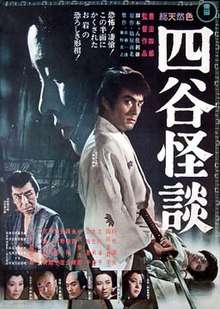Illusion of Blood
Illusion of Blood (四谷怪談, Yotsuya kaidan) (transl. The Yotsuya Ghost Story) is a 1965 Japanese film directed by Shiro Toyoda[1]
| Illusion of Blood | |
|---|---|
 | |
| Directed by | Shiro Toyoda |
| Produced by |
|
| Screenplay by | Toshio Yasumi[1] |
| Based on | Tokaido Yotsuya kaidan by Nanboku Tsuruya |
| Starring |
|
| Music by | Toru Takemitsu[1] |
| Cinematography | Hiroshi Murai[1] |
Production company | Tokyo Eiga Co. Ltd.[1] |
| Distributed by | Toho |
Release date |
|
Running time | 104 minutes[1] |
| Country | Japan[1] |
Plot
Cast
- Tatsuya Nakadai as Iuemon Tamiya
- Mariko Okada as Oiwa
- Junko Ikeuchi as Osode
- Mayumi Ozora as Oume
- Keiko Awaji as Omaki
- Kanzaburo Nakamura as Gonbei Naosuke
- Yasushi Nagata as Samon Yotsuya
- Eitaro Ozawa as Kihei Ito
- Masao Mishima as Takuetsu
- Source.[1]
Production
Illusion of Blood is based on the kabuki play Tokaido Yotsuya kaidan by Nanboku Tsuruya.[1] The play had been previously adapted to film by Shockiku as The Yotsuya Ghost Story I-II and Daiei Film as The Yotsuya Ghost Story. [1] This version of the film focuses on the increasing madness of Tatsuya Nakadai's character of Iuemon Tamiya.[1]
Release
Illusion of Blood was distributed theatrically in Japan by Toho on 25 July 1965.[1] The film was released in the United States under the title Illusion of Blood with English subtitles [1] It was distributed by Frank Lee International in March 1966.[1]
Reception
In a contemporary review, "Dool." of Variety referred to the film as a "blood-curdling Japanese ghost story" noting that the cast was "uniformly fine" and that "technical aspects, except for some abrupt cuts are first rate."[2] A second review by "Mosk." of Variety compared the film Kwaidan and Ugetsu, noting that the film lacked "classical rigor" or ""human insight and observation" that the other films had respectively.[3] Mosk. noted that the film did have "style,and good acting, excellent color and avoids violence and horror for its own sake."[3]
A retrospective review by Cavett Binion (AllMovie) found the film to be an inferior version of the film Kwaidan, opining that it was "not as visually commanding" but that it "has its share of nightmarish imagery and cultural richness."[4]
References
Footnotes
- Galbraith IV 2008, p. 221.
- Variety's Film Reviews 1964-1967. 11. R. R. Bowker. 1983. There are no page numbers in this book. This entry is found under the header March 9, 1966. ISBN 0-8352-2790-1.
- Variety's Film Reviews 1964-1967. 11. R. R. Bowker. 1983. There are no page numbers in this book. This entry is found under the header "Locarno Fest". ISBN 0-8352-2790-1.
- Binion, Cavett. "Yotuya Kaidan". AllMovie. Retrieved 29 August 2018.
Sources
- Galbraith IV, Stuart (2008). The Toho Studios Story: A History and Complete Filmography. Scarecrow Press. ISBN 1461673747.CS1 maint: ref=harv (link)